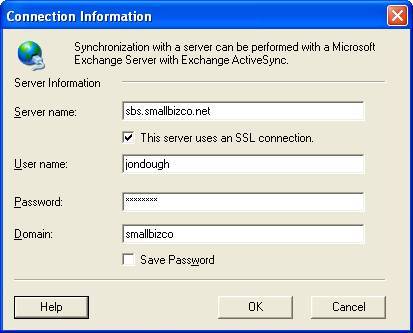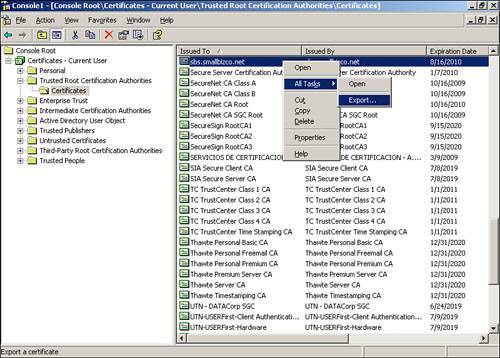| Described simply, the job of ActiveSync is to synchronize the content of mobile devices with the Exchange server. Likewise, ActiveSync can synchronize content between the mobile device and a host desktop PC to back up the mobile device in case of power failure or service replacement. ActiveSync Versions The original Windows SBS 2003 release came with ActiveSync 3.7 installed. SBS Service Pack 1 upgraded ActiveSync to version 3.8 with minor improvements and is the current version. ActiveSync 4.0 is the successor to 3.8, with support for the Windows Mobile 5.0 operating system for handheld devices. Mobile Devices PocketPCs for use with SBS 2003 are handheld devices that run either Windows Mobile 2002, 2003, or 2003 Second Edition, which is the current version. The next operating system release for PocketPCs, also slated for release in late 2005, is called Windows Mobile 5. These mobile devices fall into three categories, discussed in the following sections. PocketPC Of the three Windows Mobile device types available, PocketPCs are in the middle of the pack, regarding size; they are larger than the SmartPhones but smaller than the Phone Editions. PocketPC devices can be basic no-frills or high-end with Bluetooth, 802.1x WiFi, and can even include a digital camera. What differentiates the PocketPC from the other two categories of devices is that PocketPCs don't include a phone. The screen size is large (unlike the SmartPhone), and, depending on the model, you can enter text via a stylus or possibly a built-in or snap-on mini keyboard. Who is it for? Your typical user who needs to take her data on the road and doesn't need always-on Internet access. PocketPC Phone Edition Take everything that the PocketPC has, add built-in phone capability, make the case a bit larger to hold those extra electronics, and you have a PocketPC Phone Edition. The built-in phone is useful for making calls or data transmission. These devices are top of the line in features and capabilities. If you don't mind the larger form factor, PocketPC Phone Edition devices are as close as you can come to having your cake and eating it too. Who is it for? Road warriors, techs, and consultants who don't have time to hunt down a public WiFi hotspot, and who don't want to hassle with plugging their PocketPC into a regular cell phone. SmartPhones Take a cell phone with a normal small screen, give it the brains of a Windows Mobile device, and you've got a SmartPhone. SmartPhones come in flip-phone or conventional "eyeglass case size" form factors. They don't have a stylus for input, so they're more geared toward reading email and making calls. Who is it for? Sales reps and executives who need to keep in touch and like the smaller form factor but who don't need to send a lot of emails from the road. Synchronization ActiveSync is typically installed on the client workstation by checking the Install ActiveSync 3.8 check box when running the Set Up Client Computers Wizard in the Server Management Console. If a client machine is already a member of the domain, you can add ActiveSync by performing the following steps: 1. | Click Start, Server Management, Standard Management, Client Computers, and click Assign Applications to Client Computers.
| 2. | In the Assign Applications Wizard window, click Next, highlight the computers that need ActiveSync installed, click Add, and click Next.
| 3. | On the Client Applications screen, ignore the check boxes and just click Next.
| 4. | On the Mobile Client and Offline Use screen, check the box next to Install ActiveSync 3.8, click Next, and click Finish.
|
After adding ActiveSync 3.8 to the workstation, follow the instructions from the handheld device manufacturer for installing the cradle and initializing the PocketPC or SmartPhone. When you plug the cradle into the USB port and insert the PocketPC into the cradle, Windows XP automatically detects the device and ActiveSync launches. To properly configure ActiveSync, follow these steps: 1. | On the New Partnership screen, choose Standard Partnership, and click Next.
| 2. | When asked Specify How to Synchronize Data, choose Synchronize with Microsoft Exchange Server and/or This Desktop Computer, and click Next.
| 3. | Enter the server namefor example, sbs.smallbizco.net. The URL should match your SSL certificate and should omit the "http://" prefix.
| 4. | Check the This Server Uses an SSL Connection check box.
| 5. | Enter your domain username (for example, jondough), your domain password, your domain (for example, smallbizco), check the Save Password box, and click Next (see Figure 11.13).
Figure 11.13. ActiveSync can use your credentials to connect to Exchange through the cradle, via infrared, or across a wireless connection. 
| 6. | In the Mobile Device window, check the boxes next to Calendar, Contacts, and Inbox. By highlighting Calendar or Inbox and then clicking the Settings button, you can specify additional options such as downloading email attachments. Contacts has no additional settings. When you are finished specifying any additional options, click Next.
| 7. | On the next window, ActiveSync gives you the two options on how to handle items that may already exist on your PocketPC. The first option, Delete Any Items, is more destructive but avoids possible duplicates. The second option, Keep the Items on My Device, is a safer option but may result in duplicate items. Choose the appropriate selection for your handheld device, or if this is a new PocketPC, click OK.
| 8. | Enter a unique device name to identify this handheld. The default ID is Pocket_PC, but that ID may have already been used before. Enter an appropriate name to your liking, and click Next.
| 9. | The Select Synchronization Settings screen contains six more synchronization items: AvantGo Channels, Internet Explorer Favorites, Synchronized Files, Microsoft Outlook Notes, Microsoft Pocket Outlook Databases, and Microsoft Outlook Tasks. Important: If you select any of these items, they will only synchronize when the PocketPC is docked in the cradle. ActiveSync only synchronizes your Calendar, Contacts, and Inbox over the air remotely.
| 10. | Click Next, and click Finish. ActiveSync automatically begins synchronization. When synchronization has finished, check the status window. All items should show a status of Synchronized. If so, you're done!
|
If any items say "Sync status is on the device", you need to check the device for an error report. Most likely the device is missing the SSL certificate from the SBS server. To remedy this, follow these steps: 1. | On the PocketPC, click Start, Programs, and ActiveSync. Look for a blue hyperlink that says "Errors" and click it. If you receive an error code INTERNET_45, the PocketPC is missing the Root Certificate from the SBS server.
| 2. | To locate the Root Certificate on your desktop PC, click Start, Run, type MMC and click OK. In the MMC console, click File, Add/Remove Snap-In, and click Add. In the Add Standalone Snap-Ins window, click Certificates, Add, My User Account, and then click Finish, Close, and OK.
| 3. | To select the Root Certificate, expand Certificates - Current User, expand Trusted Root Certificate Authorities, click Certificates, and select the SBS certificatefor example, sbs.smallbizco.net (see Figure 11.14).
Figure 11.14. The Root Certificate can be found in the Console Root Directory. 
| 4. | To export the Root Certificate, right-click the certificate, click All Tasks, and click Export. The Certificate Export Wizard launches on the workstation. Click Next, select DER Encoded Binary X.509 (.CER), click Next again, and save the file on your hard drive as wirelesscert.cer. Click Next and then click Finish.
| 5. | Locate where you saved the wirelesscert.cer certificate, and, with the PocketPC still in the cradle, copy and paste the certificate to the PocketPC.
| 6. | On the PocketPC click Start, Programs, File Explorer, and locate the wirelesscert.cer on the device. Click the certificate one time, and then click Yes to install it.
| 7. | Finally, synchronize the PocketPC again. There should be no errors.
|
Note A valuable reference detailing the function of mobile devices and synchronization in a small business network is the Microsoft "Small IT Solution for Mobility," available here: http://www.microsoft.com/technet/itsolutions/smbiz/sitmob/default.mspx. To aid in troubleshooting, detailed step-by-step instructions with screen shots on how to synchronize a PocketPC with Exchange 2003 are available on Daniel Petri's, MVP's MCSEworld website: http://www.petri.co.il/how_to_sync_ppc_with_exchange_2003.htm.
|

